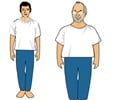Australian standards for child booster seats in cars need to be reassessed to allow for increasing rates of overweight
Australian standards for child booster seats in cars need to be reassessed to allow for increasing rates of overweight and obesity in children, according to a study in the latest Medical Journal of Australia.
Researchers from the Monash University Accident Research Centre (MUARC) in Melbourne found that of 633 children aged 4-11 years who fell within the recommended height range for using booster seats only 29 per cent were typically restrained in booster seats.“A key finding was that 37 per cent of the children who met the recommended height criteria exceeded the maximum weight for booster seats stipulated by the current Australian safety standard,” MUARC's Dr Sjaanie Koppel says.
“This appears to be a significant issue for children aged seven years and older in particular, and despite such children not meeting the minimum recommended height for use of adult restraint systems, seatbelts appear to be the preferred mode of restraint for these children.
“The use of booster seats is associated with a significantly lower risk of head and spinal injuries, internal organ injury, and lower extremity fractures than the use of seatbelts for children aged 4-7 years.
“We recommend that consideration be given to increasing the maximum child weight limit for booster seats.”
The authors also suggest the use of parental education campaigns to raise awareness of which restraint types are appropriate for children and especially when it is safe to make the transition from boosters to seatbelts.
Advertisement
Source-AMA
SUN/G








